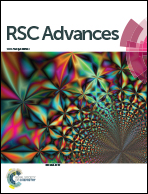Construction of a silicate-based epitaxial transition film on a zirconia ceramic surface to improve the bonding quality of zirconia restorations
Abstract
The effect of a silicate-based epitaxial transition film on zirconia produced by a silicate solution during zirconia–resin bonding was investigated. The airborne-particle abraded zirconia was placed in different concentrations of silicate solutions and heated at 50 °C. The silicate transition film was characterized by scanning electron microscopy (SEM), atomic force microscopy (AFM), energy-dispersive X-ray spectroscopy (EDX), contact angle measurement and profilometry. The silicate-based epitaxial transition film was successfully constructed on the surface of zirconia, and the surface morphology and composition of zirconia changed. After coupling with KH570 hydrolysate, the shear bond strength (SBS) of zirconia–resin after either 24 h water storage or 5000 thermal cycles can be significantly improved by a silicate-based epitaxial transition film on the surface of zirconia, and all the samples had no cytotoxicity. This may provide a new strategy for improving the bonding quality of zirconia restorations.



 Please wait while we load your content...
Please wait while we load your content...